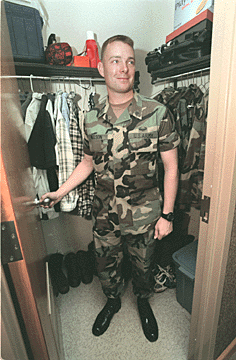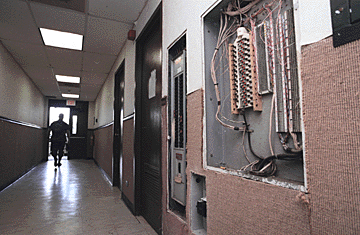


'Can you imagine, an Army
barracks with a doorbell?'
-- Sgt. Maj. Nathaniel Washington, speaking about the 1-year-old
housing complex at Schofield Barracks, part of the Army's new focus on
improving the standards of living for unmarried, enlisted soldiersBy Gregg K. Kakesako
Star-BulletinToday, when duty ends at dusk, soldiers of the 25th Infantry Division's 2nd Brigade return to a five-story, air-conditioned building where only two of them share a room and where guests can ring a doorbell to seek entry.
The Schofield Barracks rooms are wired for cable television and individual phone service. Each bedroom comes with a large walk-in closet. The colors of the walls are muted. Two soldiers share one bathroom. A common service area is equipped with a kitchen sink, refrigerator and microwave. There are more than 80 commercial-size washers and dryers available in a separate laundry room.
"Can you imagine, an Army barracks with a doorbell?" said Sgt. Maj. Nathaniel Washington, 2nd Brigade's highest ranking noncommissioned officer and a 30-year Army veteran.
"It's a far cry from the World War II Quonset huts of Camp Crockett in Georgia when I came into the Army."

The 500-unit housing complex for single enlisted soldiers under the rank of sergeant is a year-old and part of a $750 million Whole Barracks Renewal project at Schofield Barracks. More than 4,300 barracks space will be upgraded or constructed.A new 480-unit complex is under construction and will be completed by 2001.
In the proposed military construction budget now pending before Congress, the Army is requesting $95 million to build a third 400-unit complex that could be completed as early as 2003. That request is part of the $325 million the Pentagon wants to spend in Hawaii on military construction projects over the next two years.
Alan Goo, deputy director of Schofield's Directorate of Public Works, said the program, which began in 1992, is part of "the Army's aggressive program to improve the housing standard for (the) single enlisted soldier.
"For a long time the emphasis was on family housing, but not on barracks life."
Of the 37 barracks at Schofield, 50 percent were built before 1922. Their average age is 58 years. Most of them at one time were open bays where soldiers housed together in bunk beds with community latrines.
Some of them like D Quad, one of the oldest barracks on post and where much of the World War II movie "From Here to Eternity" was filmed, were open-bay units but were modified and partitioned to modules housing two soldiers each. The modules in D Quad are 90 square feet.
The three-story D Quad was built in 1921 and is now listed as a historical building, which the Army is entrusted in preserving. This means that nothing can be done to its exterior although the inside of the building can be renovated extensively.
It is showing its age.
"The biggest problem here," said one Army private, "is the lack of privacy. The walls are so thin, you can hear what is going on in the next room."

There is a comman bathroom and laundry facility for every 12 rooms in Quad D. About two dozen soldiers share a bathroom which has five commodes, five shower stalls, five sinks and mirrors and five urinals.The new units give each soldier bedroom space of 118 square feet, with an additional 21 square feet set aside for a walk-in closet. Two soldiers share a bathroom and service area.
Single noncommissioned officers above the rank of sergeant are allowed double the living area, which in effect gives them a bedroom, a separate living room and a private bathroom.
Sgt. Paul Nelson, who has been in the Army for 2-1/2 years, said his new quarters "gives me more of a feeling of home."
As a sergeant he doesn't have to share his unit with another soldier and has converted the second bedroom into a living room with a large red chair, a matching three-foot couch, coffee table, and two end tables -- all supplied by the Army.
Housing areas are located in different buildings than the operations and administration functions of the unit and the laundry and storage areas.
"The idea here is quality of life," Goo said. "It is to give the soldier more privacy. Once the soldier has left and return(ed) to his room, it's his time.
"Now the administrative offices are on the first floor of the barracks and if the sergeant needs someone, he goes upstairs and calls on the first person he sees. By separating the operations of the unit, only those on duty would get called. Soldiers in their rooms would be away and have the time to themselves."
Col. James Hirai, U.S. Army Hawaii Garrison commander, said Schofield's enlisted barracks follow Department of Defense's standards, but there is room for adjustment to meet local conditions.
For instance, Washington said he recommended that tile rather than carpet be used for much of the living areas because of Wahiawa's infamous red dirt.
"It's hard to keep off of everything," Washington said. "So with tile it's easier to clean."
The Pentagon also wants to spend $325 million here on military construction projects during the next two years: Isle military projects
$10 million to $20 million: Modernize four existing enlisted bachelor quarters at Pearl Harbor. The 175 double-occupancy modules will be similar in design to the barracks at Schofield, with two separate sleeping areas, shared bathrooms and common area with a sink, microwave, and refrigerator.
$25 million to $30 million: Replace three 1942 Pearl Harbor wharves to facilitate ship repair and submarine maintenance.
$5 million to $15 million: Consolidate Pearl Harbor's abrasive blast and paint facility in one location.
$25 million to $100 million: Construct a new building for the commander in chief of the Pacific at Camp Smith.
$26 million: Construct 100 family housing units at Kaneohe Marine Corps Base.